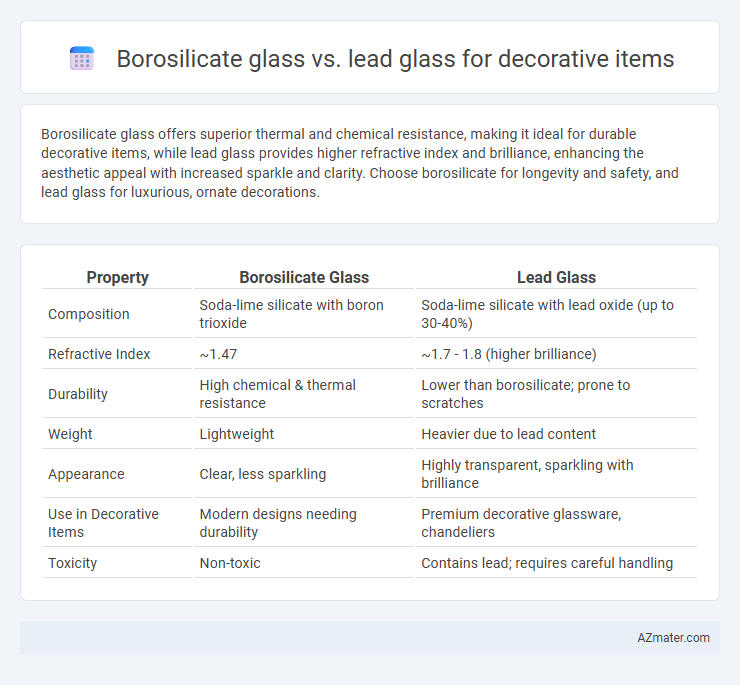Borosilicate glass offers superior thermal and chemical resistance, making it ideal for durable decorative items, while lead glass provides higher refractive index and brilliance, enhancing the aesthetic appeal with increased sparkle and clarity. Choose borosilicate for longevity and safety, and lead glass for luxurious, ornate decorations.
Table of Comparison
| Property | Borosilicate Glass | Lead Glass |
|---|---|---|
| Composition | Soda-lime silicate with boron trioxide | Soda-lime silicate with lead oxide (up to 30-40%) |
| Refractive Index | ~1.47 | ~1.7 - 1.8 (higher brilliance) |
| Durability | High chemical & thermal resistance | Lower than borosilicate; prone to scratches |
| Weight | Lightweight | Heavier due to lead content |
| Appearance | Clear, less sparkling | Highly transparent, sparkling with brilliance |
| Use in Decorative Items | Modern designs needing durability | Premium decorative glassware, chandeliers |
| Toxicity | Non-toxic | Contains lead; requires careful handling |
Introduction to Borosilicate and Lead Glass
Borosilicate glass, known for its exceptional thermal resistance and durability, contains silica and boron trioxide, making it ideal for both functional and decorative items that require strength and clarity. Lead glass, also called crystal glass, incorporates lead oxide to enhance its refractive index, providing superior brilliance and weight, which is favored in decorative pieces like vases and chandeliers. The differences in composition directly influence their appearance, strength, and typical applications in decorative arts.
Historical Background of Decorative Glass
Borosilicate glass and lead glass have distinct historical backgrounds influencing their use in decorative items. Lead glass, developed in the 17th century, became prized for its brilliance and high refractive index, making it ideal for ornate crystalware and luxury decor. Borosilicate glass, invented in the late 19th century, is valued for its durability and thermal resistance, enabling innovative decorative designs in contemporary and functional art glass.
Composition and Material Properties
Borosilicate glass contains silica and boron trioxide, providing high thermal resistance and durability, making it ideal for decorative items requiring longevity and heat resistance. Lead glass, composed of silica, lead oxide, and potassium oxide, offers high refractive index and brilliance, enhancing the sparkle and clarity of decorative pieces. Borosilicate glass is more chemically stable and scratch-resistant, while lead glass is softer but excels in optical properties for artistic effects.
Aesthetic Differences in Decorative Use
Borosilicate glass offers a crisp, clear appearance with high resistance to thermal shock, making it ideal for modern, minimalist decorative items that emphasize transparency and durability. Lead glass, on the other hand, is prized for its brilliant clarity and heavy refraction, producing sparkling, vibrant visuals perfect for intricate, ornate designs and traditional decorative pieces. The aesthetic difference lies in borosilicate's sleek, understated elegance versus lead glass's rich, luminous brilliance that enhances decorative richness.
Durability and Resistance to Damage
Borosilicate glass offers superior durability and resistance to thermal shock due to its low coefficient of expansion, making it less prone to cracking or breakage compared to lead glass. Lead glass, while prized for its brilliance and clarity, tends to be softer and more susceptible to scratches and chipping during handling. For decorative items requiring long-lasting strength and minimal damage, borosilicate glass is the more resilient choice.
Safety and Health Considerations
Borosilicate glass is preferred for decorative items due to its excellent thermal resistance and chemical stability, ensuring minimal risk of leaching harmful substances into the environment. Lead glass contains lead oxide, which, despite its brilliant clarity and weight, poses health risks through potential lead exposure, especially if damaged or used with food or drink containers. Choosing borosilicate glass enhances safety by reducing toxic exposure and supporting a non-toxic, eco-friendly decorative option.
Environmental Impact and Sustainability
Borosilicate glass, known for its high thermal resistance and durability, offers a more environmentally friendly option compared to lead glass, as it contains no toxic elements and is easier to recycle. Lead glass, while prized for its clarity and brilliance in decorative items, poses significant environmental concerns due to lead content, which can lead to soil and water contamination if not properly managed. Sustainable choices favor borosilicate glass to minimize ecological footprint and ensure safer disposal and recycling processes.
Cost Comparison for Decorative Items
Borosilicate glass typically costs more than lead glass due to its superior thermal resistance and durability, making it a premium choice for decorative items requiring long-lasting quality. Lead glass, known for its brilliance and ease of molding into intricate designs, is generally less expensive but may pose health concerns and lower heat resistance. Cost considerations for decorative items often balance the higher price of borosilicate with its enhanced safety and durability versus the affordability and aesthetic appeal of lead glass.
Popular Applications in Home Decor
Borosilicate glass is favored for decorative items such as glass vases, candle holders, and terrariums due to its high thermal resistance and durability, making it ideal for functional and artistic home decor pieces. Lead glass, known for its brilliance and clarity, is predominantly used in luxury decorative items like crystal bowls, ornate chandeliers, and collectible figurines, adding elegance and sparkle to interior design. Both types of glass offer distinct advantages, with borosilicate excelling in practical applications and lead glass enhancing aesthetic appeal in upscale home decoration.
Choosing the Right Glass for Your Decorative Needs
Borosilicate glass offers superior thermal shock resistance and durability, making it ideal for decorative items exposed to temperature changes or frequent handling. Lead glass provides exceptional clarity and brilliance, enhancing the aesthetic appeal of decorative pieces with its high refractive index and weight. Selecting the right glass depends on whether durability or optical elegance is the priority for your decorative needs.

Infographic: Borosilicate glass vs Lead glass for Decorative item
 azmater.com
azmater.com